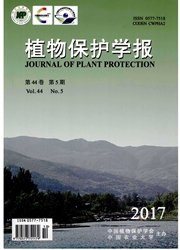

 中文摘要:
中文摘要:
通过野外调查和资料分析,对河南不同类型农田杂草区系及生态分布特点进行研究。结果表明:河南有农田杂草701种,隶属于343属、83科;属的分布区可划分为15个类型和14个变型,其中温带成分占除世界分布属以外的65.30%(下同),热带成分占33.58%,反映出北亚热带与南暖温带过渡的性质;种的区系成分复杂,可归为15种分布类型,以泛热带分布、北温带分布、旧世界温带分布、东亚分布和中国特有分布占优势;杂草的生态分布具有广泛性、南北交错、南北分布差异等特点,其对农田的危害表现出麦田、秋田、水田、果园、荒地等时空生态位的多重变化。根据杂草时空生态分布特点,在农业生产中应加强秋田和果园杂草的防治力度。
 英文摘要:
英文摘要:
Its various physical environments and long geologic history made it abundant in weed species with complex floristic elements in Henan Province. For further effective control of farmland weeds, improve the production of crop yields, the investigation was conducted by field survey and date analysis. The results demonstrated that there are 701 species of farmland weeds, belonging to 343 genera and 83 families in Henan. The areal-types of the genera and the species are abundant. Based on their geographical distribution, 343 genera are classified into 15 areal-types, most belonging to the temperate distribution pattern plant (65.30%), others belonging to tropical (33.58%), excluding the world genera. That the 701 species distributed in Henan can be divided into 15 areal types. These types, pantropic, North Temperate, Old World trop, East Asiaand endemic to Chinagain upper hand, and show the character of transition conspicuous. It is harmful to farmland that showed the complex changes of spatial niche to wheat field, autumn field, paddy field, orchard and wasteland. Based on the character of weed spatial distribution, it should be improved that the strength of prevention to weeds in autumn fields and orchards, applied to agricultural production.
 同期刊论文项目
同期刊论文项目
 同项目期刊论文
同项目期刊论文
 Unusual kinematics-driven chemistry: Cleaving C-H but not COO-H bonds with hyperthermal protons to s
Unusual kinematics-driven chemistry: Cleaving C-H but not COO-H bonds with hyperthermal protons to s Fabrication and electrochemical performance of nickel ferrite nanoparticles as anode material in lit
Fabrication and electrochemical performance of nickel ferrite nanoparticles as anode material in lit A new cross-linking route via the unusual collision kinematics of hyperthermal protons in unsaturate
A new cross-linking route via the unusual collision kinematics of hyperthermal protons in unsaturate Low-temperature preparation of nanocrystalline TiO2 photocatalyst with a very large specific surface
Low-temperature preparation of nanocrystalline TiO2 photocatalyst with a very large specific surface Study of the hyperthermal proton bombardment effects on self-assembled monolayers of dodecanethiol o
Study of the hyperthermal proton bombardment effects on self-assembled monolayers of dodecanethiol o Fabrication of cross-linked multi-walled carbon nanotube coatings with improved adhesion and intrins
Fabrication of cross-linked multi-walled carbon nanotube coatings with improved adhesion and intrins Using elemental Se and Ag to grow pure Ag2Se dendrites/dendritie-films of highly oriented (001) nano
Using elemental Se and Ag to grow pure Ag2Se dendrites/dendritie-films of highly oriented (001) nano A novel two-dimensional cadmium polymeric aminonaphthalene sulfonate and its application in the synt
A novel two-dimensional cadmium polymeric aminonaphthalene sulfonate and its application in the synt 期刊信息
期刊信息
